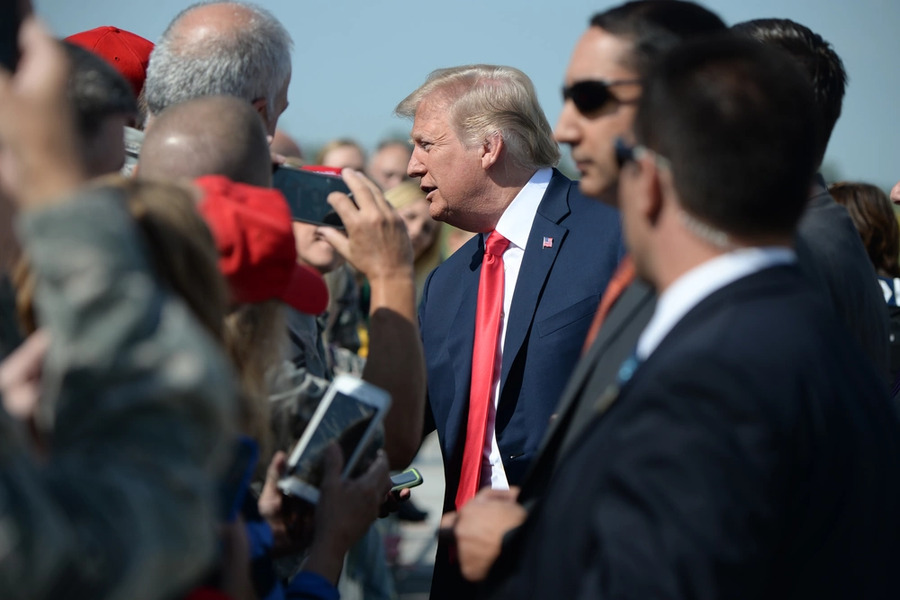Mexico's Next Move
Over the past two weeks, U.S.-Mexico relations deteriorated to their lowest point since perhaps the era of Pancho Villa.
Published by The Lawfare Institute
in Cooperation With

Over the past two weeks, U.S.-Mexico relations deteriorated to their lowest point since perhaps the era of Pancho Villa. The spat began in earnest when President Donald Trump signed his two executive orders pertaining to immigration and the border wall, even as Mexico’s negotiating delegation was getting situated in Washington D.C. Trump’s subsequent tweet telling Mexico’s president to pay for the border wall or cancel his January 31st visit to the White House sealed the relationship’s fate, with President Enrique Peña Nieto staying put in Mexico City and Mexicans rallying around their deeply unpopular president.
While the Mexican government is quietly continuing its negotiations over NAFTA, immigration, and border issues, there is a growing chorus of voices asking Peña Nieto to rethink his strategy and adopt a stronger position against the United States. Mexico, these public intellectuals argue, has quite a few cards tucked up its sleeve for the negotiations and overall bilateral relations with the United States and shouldn’t be afraid to put them on the table.
Are they right? Let’s go through these supposed cards and whether they would be worth playing.
#1. Allowing Central American Migrants Safe Passage to the U.S.-Mexico Border
Mexico’s first alleged card is refusing to collaborate with the United States on Central American migration. In 2014, Mexico purportedly agreed to step up cooperation on immigration enforcement, boosting security along its southern border with Guatemala and ramping up its own deportation forces. You can see the data for yourself in this graph of Mexico’s monthly Central American deportations (along with a comparative view of monthly U.S. border apprehensions of Central Americans):
*Data from Secretaría de Gobernación and U.S. Customs and Border Patrol (through a Freedom of Information Act request).
To pressure the United States, Mexico could slow down these enforcement efforts or issue Central American migrants some form of temporary visa that would allow them a free pass to the U.S.-Mexico border, possibly doubling the number of arrivals that U.S. officials would have to process.
By allowing Central Americans to move freely through the country, Mexico would permit the migrants to flood the border, overwhelm the U.S. border patrol, and thus highlight the critical bilateral security partnership that Trump is slighting. This would be aimed at pressuring Trump to negotiate a better deal with Mexico or to even out their positions.
However, this move could also seriously backfire. First, it would play directly into Trump’s narrative of an out-of-control border, which would do little to improve Mexico’s image in the United States. Second, this approach is somewhat contingent on the United States enforcing its asylum laws and accepting migrants at ports of entry, which has not always been the case. Exhibit A: the several thousand Haitian migrants that were stranded in Baja California at the end of 2016.
If things don’t go as planned, there could be hundreds of thousands of Central Americans stuck or at least temporarily residing on the Mexican side of the border, creating a true humanitarian crisis. Worse still, this approach means playing politics with an extraordinarily vulnerable population without offering them any real solutions.
#2. Delaying U.S. Deportations
For each formal U.S. deportation, there are two parts: a formal removal (deportation) notice from the United States and travel documents on the receiving country end. If Mexico demanded that it would only accept Mexicans who have their documents, as leading public intellectual and former Mexican Foreign Minister Jorge Castañeda has suggested, it would slow down these deportations. These migrants could be held in detention for up to 180 days and then U.S. law requires that they be released. However, blocking these releases was one of Trump’s central immigration proposals on the campaign trail.
Adding sand to the deportation force gears would be a major pain for the United States. It would crowd detention centers and backup bureaucratic processes. In turn, this could bring attention to the importance of bilateral cooperation on immigration issues, with the aim once again of pressuring Trump to negotiate on more equal terms with the Mexican government.
Yet, deliberately delaying the U.S. deportation process opens up new options for Trump’s response. According to section 243d in the U.S. Immigration and Nationality Act, if a foreign country refuses to accept its deportees or delays the deportation process, the United States can stop issuing visas to that country’s citizens and residents. This would give Trump the legal path to take away certain U.S. visas from Mexicans (and he has already threatened to raise fees on visas for Mexican diplomats and business travelers to pay for his border wall).
Worse still, this again puts a vulnerable population at the center of a political skirmish. The affected immigrants could be forced to remain in U.S. detention centers for up to six months or perhaps longer if Trump succeeds in fulfilling his campaign promise.
#3. Accept or Speed Up NAFTA’s Death
Then there’s Mexico’s nuclear option: bidding adios to NAFTA. This option would either entail Mexico pulling out of negotiations with Trump’s team (and effectively killing NAFTA) or taking the preemptive step of killing it themselves. Either option could occur if the Mexican government did not believe the Trump administration to be negotiating in good faith. If this was the case, the Mexican government could walk out of the negotiations at any time or unilaterally invoke Article 2205, giving the United States and Canada six months notice and effectively ending trilateral free trade.
Ending NAFTA would release Mexico from the Trump administration’s economic blackmail and relieve the current uncertainty that is slowing inbound foreign investment and weakening the peso (ironically making Mexican products cheaper for U.S. consumers and widening the bilateral trade deficit). It would also allow the Mexican government to avoid lengthy and damaging negotiations that could ultimately be fruitless and immediately adopt policies to diversify and stimulate its economy.
But breaking up NAFTA would quite literally be the death of modern North American economic integration. It would cut deeply into the nearly $600 billion per year bilateral trade, slash economic growth, reshuffle business operations and manufacturing supply chains, and hurt both Mexican and American workers. Consumers in both countries would also pay more for everything from fruits to televisions to cars. Plus, there would likely be no turning back or negotiating a new agreement, given the United States’ anti-trade political climate.
There could perhaps be some space for “nuclear-lite options,” involving targeted tariffs on goods produced in the congressional districts whose representatives or senators support Trump. This would be similar to what former Mexican President Felipe Calderón successfully pulled off during the 2009 NAFTA trucking dispute. However, even the rhetorical threat of such specific action could be deemed as too provocative during this tense period.
***
These are just three of Mexico’s possible cards for evening out the negotiating table, with other suggestions ranging from filing a formal United Nations complaint regarding Trump’s border wall to revisiting Mexican drug policies to abandoning tough border security. Yet, despite what recent op-eds and fiery nationalistic language might suggest, it appears that all of these cards are either fairly weak, prone to domestic backlash, or incredibly risky to Mexico's own self interest.
With few, if any, attractive options, Mexico has the choice to play either its riskiest cards, their lite-versions, or to stall for more time (which may be the latest strategy). But the fact that we are in the midst of a high-stakes diplomatic game is in itself already exacting immeasurable damage. Both countries might be strategizing their next moves, but when decades of trust, cooperation, and goodwill are tossed to the side by a series of tweets and canceled meetings, we’ll all lose.



.jpg?sfvrsn=564b5f50_5)


